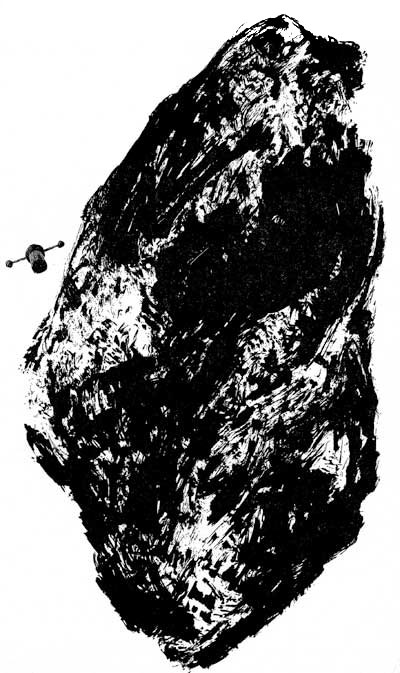Transcriber's Note:
This etext was produced from Analog Science Fact & Fiction December 1963. Extensive research did not uncover any evidence that the U.S. copyright on this publication was renewed.

THIN EDGE
There are inventions of great value that one type of societycan use—and that would, for another society, be mostnastily deadly!
BY JOHNATHAN
BLAKE MAC KENZIE
ILLUSTRATED BY JOHN SCHOENHERR
I
"Beep!" said the radio smugly. "Beep! Beep! Beep!"
"There's one," said the man at the pickup controls of tugship 431. Hechecked the numbers on the various dials of his instruments. Then hecarefully marked down in his log book the facts that the radio finderwas radiating its beep on such-and-such a frequency and that thatfrequency and that rate-of-beep indicated that the asteroid had beenfound and set with anchor by a Captain Jules St. Simon. The directionand distance were duly noted.
That information on direction and distance had already beentransmitted to the instruments of the tugship's pilot. "Jazzy-o!" saidthe pilot. "Got 'im."
He swiveled his ship around until the nose was in line with the beepand then jammed down on the forward accelerator for a few seconds.Then he took his foot off it and waited while the ship approached theasteroid.
In the darkness of space, only points of light were visible. Off tothe left, the sun was a small, glaring spot of whiteness that couldn'tbe looked at directly. Even out here in the Belt, between the orbitsof Mars and Jupiter, that massive stellar engine blasted out enoughenergy to make it uncomfortable to look at with the naked eye. But itcould illuminate matter only; the hard vacuum of space remained dark.The pilot could have located the planets easily, without lookingaround. He knew where each and every one of them were. He had to.
A man can navigate in space by instrument, and he can take the time tofigure out where every planet ought to be. But if he does, he won'treally be able to navigate in the Asteroid Belt.
In the Nineteenth Century, Mark Twain pointed out that a steamboatpilot who navigated a ship up and down the Mississippi had to be ableto identify every landmark and every changing sandbar along the riverbefore he would be allowed to take charge of the wheel. He not onlyhad to memorize the whole river, but be able to predict the changes inits course and the variations in its eddies. He had to be able to knowexactly where he was at every moment, even in the blackest of moonlessnights, simply by glancing around him.
An asteroid man has to be able to do the same thing. The human mind iscapable of it, and one thing that the men and women of the Belt Citieshad learned was to use the human mind.
"Looks like a big 'un, Jack," said the instrument man. His eyes wereon the radar screen. It not only gave him a picture of the body of theslowly spinning mountain, but the distance and the angular and radialvelocities. A duplicate of the instrument gave the same information tothe pilot.
The asteroid was fairly large as such planetary debris went—some fivehundred meters in diameter, with a mass of around one hundredseventy-four million metric tons.
Within twenty meters of the surface of the great mountain of stone,the pilot brought the ship to a dead stop in relation to that surface.
"Looks l